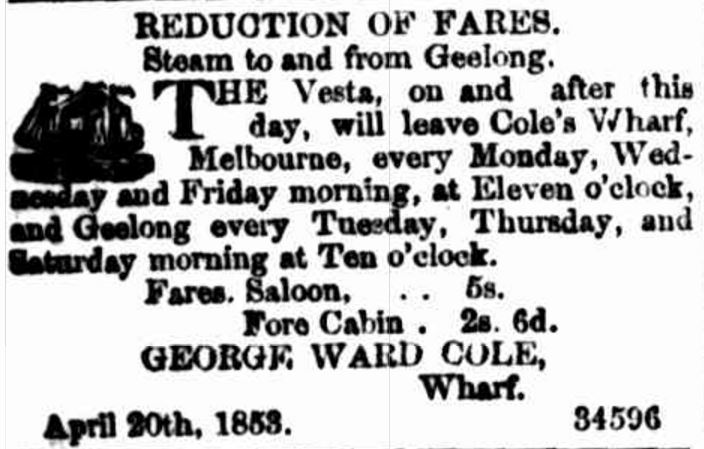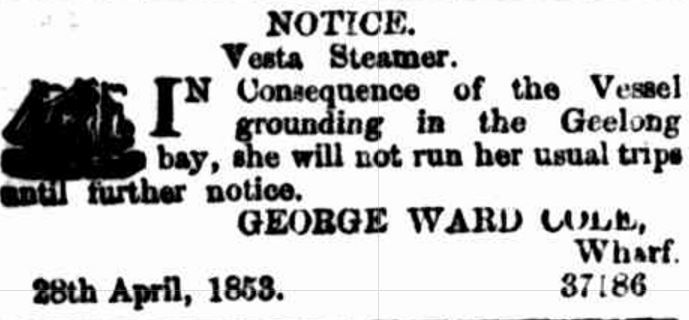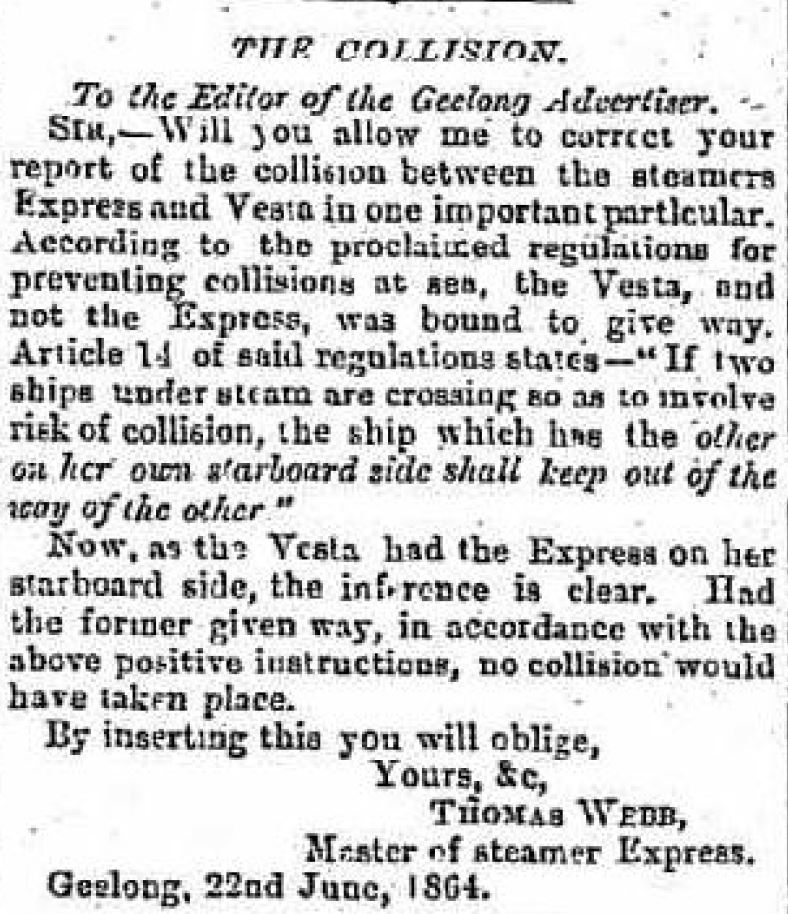The PS ‘Vesta’ was a paddle steamer, in England, c 1841.
Extensive research has declined to reveal the particulars of this vessel, the build date, the builder, etc. We have determined that the PS ‘Vesta’ was an iron paddle steamer, which was imported into Melbourne in pieces by a Flinders Street merchant, Mr. Frederick Manton, and assembled on the banks of the Yarra River, opposite ‘Queens Wharf’ in 1842. She was powered by 2 x 15 hp steam engines and serviced the bay trade at least until the late 1860’s. She transported cargo, mail and passengers, as well as partook in a number of rescues.
” . . . One bright sunny morning we took our passage on board the Vesta steamboat at Melbourne for Geelong. This vessel is a small iron boat, having two engines, each of fifteen-horse power; she was imported from England upwards of twelve years ago, and was brought to the colony in pieces. We started from the Queen’s Wharf punctually at seven o’clock, and reached Geelong at half-past twelve, making the voyage in five hours and a half, including a stoppage at Williamstown of half an hour. This little vessel is well commanded by Captain Wetheridge, and has every comfort and convenience on board that the most fastidious passenger could wish for, and would bear comparison with the best river-boats in the United Kingdom. While proceeding down the river, we partook heartily of a substantial breakfast on board, served up in the best style and at a reasonable charge. As we looked around the breakfast-table upon our fellow-passengers, we could not but observe with what keen appetites they dispatched the savoury dishes of pork-chops, grilled fowls, beefsteaks smothered in onions, accompanied by hot potatoes, which composed this early meal; but for the tea and coffee, we should have supposed it dinner instead of breakfast. The quantity of animal food consumed in this country is extraordinary; almost every one eats meat three times a day. In the hottest weather too it seems to make no difference, where in other countries the appetite refuses to attack animal food in the summer; and yet no bad effects upon the general health of the community from this cause have been perceived. It would appear as if the invisible secretions of the body, which the dry warm atmosphere of Australia absorbs so abundantly, require a large amount of strong nourishing food to reproduce them and keep up the system—not the attenuated frame of the aborigine, but that portly figure which the Englishman loves to display . . . “
Source: Excerpt – ‘Australia Visited & Revisited – A Narrative of Recent Travels & Old Experiences in Victoria & New South Wales’ – by Samuel Mossman & Thomas Banister – published 1853
.
Timeline:
1842 → the PS ‘Vesta was launched on the Yarra River
” . . . The first steamer built on the Yarra was the ‘Vesta,’ an iron paddle-steamer imported by the Messrs. Manton, from England, and put together opposite the Queen’s Wharf. She was launched in fine style, decorated with bunting, crowded with people, and Tickel’s band merrily playing ‘ Off She Goes.’. . . “
” . . . Attempts were gradually made to erect small premises for boat repairing, and by degrees, three of these not considerable establishments acquired the nominal distinction of being known as docks. One was owned by a Mr. Charles Chessel, another by a Mr. Kell, and a third by a Mr. Kruse. The scanty requirements of the port were efficiently ministered to, and so early as 1842 we hear of a spruce little steamer, the “Vesta,” being fitted up at the south bank of the river, and launched there in the presence of several hundred spectators. She was imported by Mr. Frederick Manton, an early merchant and mill proprietor in Flinders Street. . . “
Source: Excerpts – ‘The Chronicles of Early Melbourne – 1835 to 1851 – Vol II’ – by Garryowen – published 1888
1 May 1842 → the PS ‘Vesta’ commenced the runs between Melbourne – Williamstown, and, Melbourne – Geelong
” . . . On the 1st May 1842, the “Vesta,” belonging to F. Manton and Co. was put on between Melbourne and Williamstown—on week-days three trips per diem, and a trip to Geelong every Sunday . . . “
Source: Excerpt – ‘The Chronicles of Early Melbourne – 1835 to 1851 – Vol II’ – by Garryowen – published 1888
15th Mar 1845 → the PS ‘Vesta’ released the grounded ‘Sarah Scott’ in Corner Inlet, located in the north-eastern waters, off Wilsons Promontory
Oct 1843 → the PS ‘Vesta’ began assisting the PS ‘Aphrasia’ in transporting mail between Melbourne and Geelong as travel by water was deemed safer (overland mail was frequently targeted and robbed by bushrangers), quicker and more reliable:

Argus (Melbourne, Vic) – 12 May 1853
“ . . . In June 1839, William Wright commenced a weekly passenger and parcel service by wagon between Melbourne and Geelong. This carried parcels for 2/6d each. A contract to carry mail was awarded to Wright on 2 March 1840. He was required to leave Melbourne every Friday morning and deliver the mail in Geelong that evening. The return journey was undertaken on Sundays. However, the overland mail route operated for only 18 months. The authorities considered Wright’s contract to be too costly and a cheaper alternative by sea was sought.
In July 1841, a regular service by the steamer Aphrasia commenced between Melbourne and Geelong. Wright’s contract was ended on 9 September that year and Aphrasia began carrying mails. The steamer initially operated twice a week, but this was increased to thrice weekly in June 1842. Following the introduction of a second steamer, Vesta in October 1843, steamers operated daily (Sundays excepted). However, Vesta was withdrawn from service in late February 1844 and Aphrasia operated alone on three days a week. A daily steamer service was re-established by late 1846, following the return of Vesta. A notice of 28 November 1846 in the Port Phillip Government Gazette advises sailing times of the two steamers. For the remainder of the existence of the Port Phillip District, mail between Melbourne and Geelong continued to be carried by steamer . . . “
Source: Excerpt – “Inland Mail Routes of the Port Phillip District, 1838-1851” – by Richard Breckon – published 1998
15th Apr 1846 → the PS ‘Vesta’ made numerous attempts, in vain, to release the grounded cutter ‘Tasman’ from the sands near Mount Martha – the hull eventually abandoned
14 Mar 1864 → the PS ‘Vesta’ went to the rescue of the crew of the capsized schooner ‘Melbourne’:
” . . . CAPSIZING OF THE SCHOONER MELBOURNE. – Intelligence reached town yesterday morning, by telegram, that the schooner Melbourne, Capt. Grant, had capsized in the West Channel, while on her voyage from Warnambool for Melbourne, laden with a cargo of wool, potatoes, and hides. Captain Grant, who with his crew arrived yesterday afternoon by the steamer Vesta, reports the following: – “Entered the Heads at forty-five minutes past five a.m. yesterday, and was proceeding up the West Channel with wind at W.N.W., blowing strong, when between No. 8 and No. 10 buoys, at about half-past six a.m., the vessel was struck by a heavy sudden squall, and immediately capsized.” Captain Grant, who was on deck at the time, with his crew, scrambled on to the bottom of the vessel, and there remained for about half an hour, when they were seen from the steamer Vesta, while on her passage from Queenscliff to Schnapper Point, and which immediately proceeded to their assistance, and fortunately succeeded in rescuing them all, although in a very exhausted condition. Capt. Grant and his crew have lost everything, with the exception of those they had on. The vessel was the property of her commander, and was insured but for a small sum. Great credit is due to the master and crew of the Vesta for the prompt manner in which they rescued the ship-wrecked crew. Commanders of vessels, pilots, and others, are informed by the chief harbor-master, that the Melbourne now lies on her starboard side aground, in two fathoms at low water, on the east side of the fair-way, a little to south-west of the north-west Elbow Perch Buoy. Until the vessel is removed, a red flag by day, and two white flags by night, will be exhibited from the mast of a vessel moored close to the Melbourne. – Argus . . . “
Source: Excerpt – ‘Lyttelton Times’ (NZ) – published 15th March 1864
21 Jun 1864 → the PS ‘Vesta’ was deemed responsible for the collision with the steamer ‘Express’
” . . . The Steam Navigation Board have been engaged for the last two days in an inquiry as to the circumstances attending the collision which took place between the steamers Express and Vesta, in Hobson’s Bay, on the evening of the 21st ult. After the examination of about a dozen witnesses, the board came to the conclusion that the collision was attributable to the want of a proper look-out on board the Vesta. The members of the board who conducted the inquiry were – Captain B. R. Matthews, Mr. Q. A. Stephen, and Mr. A. Sutherland . . . “
Source: Excerpt – ‘Argus’ Melbourne, Vic) – published 1st July 1864
In Conclusion . . .
Records from the very first years of the establishment of Melbourne, in a time before infrastructure, law, order, communications and newspapers were of the crudest form, there is great difficulty in establishing the details of many of the occurrences of the time. The following provides an alternative account as to the first vessel to be built on the Yarra River:
” . . . I am indebted to Mr. J. J. Lander, of Grey Street, East Melbourne, for the following, which differs slightly from the above:-
“The very first vessel that was ever built on the banks of the Yarra, viz., the “Yarra Yarra” barge, was an ugly square-head and square stern sort of structure, that would hardly be used to carry out silt at the present day, but which was very useful and profitable at the time she was engaged in the lightering trade between Williamstown and Melbourne. She was built by Messrs. Manton and Walker, who were at that time in a large way of business in Melbourne as merchants, to do their work until the “Vesta” Steamer arrived, which latter was not delivered in Melbourne for over two years after she was ordered. Messrs. Manton and Walker had induced a Captain J. C. Lander, who was connected with them in squatting pursuits in New South Wales (as superintendent of a station there, with an interest in the profits), to throw up sheep-farming to come to Melbourne and take charge of the “Vesta;” but as she was so long on the way they had to find him another vessel, and the building and launching of the “Yarra Yarra” was the result. I think the “Yarra Yarra” was launched in the latter part of 1841. – (The Author) . . . “
Source: Excerpt – ‘The Chonicles of Melbourne – 1835 to 1851 – Vol II’ – by Garryowen – published 1888
.
Additional Resources: Websites: ‘Shipwrecks of Port Phillip & The Rip’
.
View other important events in the history of The Steamers of Port Phillip Bay . . .




